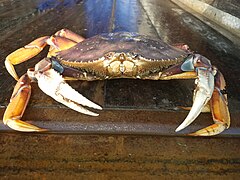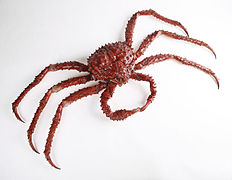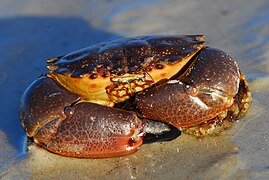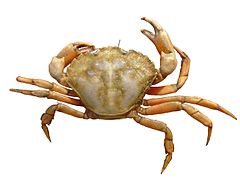Cookbook:Crab
| Crab | |
|---|---|
 | |
| Category | Shellfish |
Cookbook | Recipes | Ingredients | Seafood
Crabs are crustaceans related to shrimp, crayfish, lobster, and krill.
Characteristics[edit | edit source]
For the most part, all of the crabs listed here have a body with a hard shell, several legs, and a pair of claws. Depending on the type of crab, they yield meat from both the body and the legs/claws.[1] The leg meat is somewhat like lobster meat.[1]
Blue crab[edit | edit source]
This crab is common to the western Atlantic Ocean and introduced elsewhere.[2][3] It has a bluish brown shell, about 4–5 inches across, and legs adapted for swimming.[2][3] It yields meat primarily from the body, and it has a delicate texture.[3]
Dungeness crab[edit | edit source]
This crab is found on the west coast of the United States and has a brownish purple shell. The meat is considered sweet and delicate.[3][4]
Common crab[edit | edit source]
The common crab is native to the eastern Atlantic Ocean. It yields about a third of its body weight in meat, a significant portion of which is considered "brown meat".[1]
Stone crab[edit | edit source]
Stone crabs are found in the Southeastern United States and Mexico.[3] Only the claws, which have black tips, are eaten, and the meat is solid and firm like that of lobster meat.[3][4]
King crab[edit | edit source]
The king crab, sometimes called the Alaskan king crab due to a common habitat, is a very large crab about 6–20 lb (2.7–9 kg) in weight with very long spiky legs.[3][4] The shell comes in three different colors of brown, red, and blue.[3] The legs yield a good deal of firm meat that can be removed in entire chunks,[4] and the body and upper legs have a more tender flaky texture.[3]
Snow crab[edit | edit source]
Similar in appearance to the king crab but smaller (about 1–6 lbs / 0.5–3 kg), snow crabs also have very long, spidery legs and a red shell.[3][4] The meat is mildly sweet and has a more fibrous texture than "lump" crab meat.[1][3]
Soft-shell crab[edit | edit source]
Soft-shell crabs are just regular crabs (often blue crabs) that have just molted and have not hardened their new shell yet.[4] The meat is very tender and delicate, which makes them commonly sautéed or fried and eaten whole.[3][4]
-
 Dungeness crab
Dungeness crab -
 Blue crab
Blue crab -
 King crab
King crab -
 Snow crab
Snow crab -
 Stone crab
Stone crab -
 Common crab
Common crab
Seasonality[edit | edit source]
Some crabs, like the Dungeness and Jonah crab are available fresh year-round.[3] Blue crabs are available spring through fall, king crabs fall through winter, and stone crabs fall through spring.[3]
Selection and storage[edit | edit source]
Crab is typically purchased live or preserved by canning or freezing,[3] since the enzymes in crabs make the meat deteriorate very rapidly.[4][5] Live crabs should wave their arms around when poked—avoid crabs that don't show signs activity.[2] Keep fresh crab alive until shortly before cooking.[2][3][4] Frozen crab meat should be thawed in the refrigerator to preserve the texture, then used quickly; it's liquid can be squeezed out and used in dishes.[3][4]
Preparation[edit | edit source]
If preparing live hard-shell crab, you will find two main schools of thought: those who put the live animal into a pot of boiling water and those who, finding this inhumane, kill the crab just prior to preparation. To kill the crab before boiling, the usual method is to flip the crab onto its back and lift up the apron (the triangular flap pointing towards the head). You will notice a small hole. Drive a sharp screwdriver or slender knife quickly through the hole. Do not be shy: you want this to be a strong thrust that reaches to (but not through) the shell on the other side. Prepare immediately afterward.
Whether live or freshly killed, the crab should go into a large pot full of heavily salted boiling water. Extra seasoning isn't required, but adding a spice mix such as Old Bay can add tremendous flavor to the final result. Putting the crabs in will lower the water's temperature, so cover the pot and bring the water back to a boil. Then reduce to a simmer and cook for 12–15 minutes for crabs under three pounds,[4] 15–20 for larger crabs. Alternatively, you can steam the crabs.
Once done, remove the crab and rinse with cool water to stop the cooking process.[4] Next remove the apron;[4] once it has been removed, stick your thumb through the hole left behind and lift up to remove the outer shell. Pull off the gills (the feathery grey ring behind the eyes) and decide whether you wish to keep the brownish insides.[4] They are called tomalley and are the crab's guts, if you will. Tomalley is edible (and considered a delicacy to some), so scoop it out and serve alongside the crab if you like. But you can also simply rinse it out under running water if you prefer. At this point, all that is left is to crack open the crab, extract the meat, and enjoy.[4] The legs can be opened with a mallet or tool like a nutcracker.[3][4]
Soft-shell crabs should be cleaned before cooking by cutting off the head region, then removing the gills and aprons.[3][4] To prepare previously killed and cooked crab, you only need to reheat it by steaming or baking for a few minutes—be careful not to overcook the meat.
Use[edit | edit source]
With hard-shell crab, often just the legs are served, along with the portion attached to the leg and the claws. The meat is commonly served with melted butter, lemon, and a variety of sauces. Crab cakes are made from crab meat mixed with other ingredients before being shaped, breaded, and fried/baked.[2][3] The cooked meat can also be included in soups, salads, and seafood boils.[3] Soft-shell crab is often battered and fried.[2]
Recipes[edit | edit source]
References[edit | edit source]
- ↑ a b c d Davidson, Alan (2014-01-01). Jaine, Tom (ed.). The Oxford Companion to Food. Oxford University Press. doi:10.1093/acref/9780199677337.001.0001. ISBN 978-0-19-967733-7.
- ↑ a b c d e f Kipfer, Barbara Ann (2012-04-11). The Culinarian: A Kitchen Desk Reference. Houghton Mifflin Harcourt. ISBN 978-0-544-18603-3.
- ↑ a b c d e f g h i j k l m n o p q r s t u America, Culinary Institute of; Ainsworth, Mark (2009-02-04). Kitchen Pro Series: Guide to Fish and Seafood Identification, Fabrication and Utilization. Cengage Learning. ISBN 978-1-4354-0036-8.
- ↑ a b c d e f g h i j k l m n o p q Gisslen, Wayne (2014-04-15). Professional Cooking. Wiley. ISBN 978-1-118-63672-5.
- ↑ Gibson, Mark (2018-01-04). Food Science and the Culinary Arts. Academic Press. ISBN 978-0-12-811817-7.





